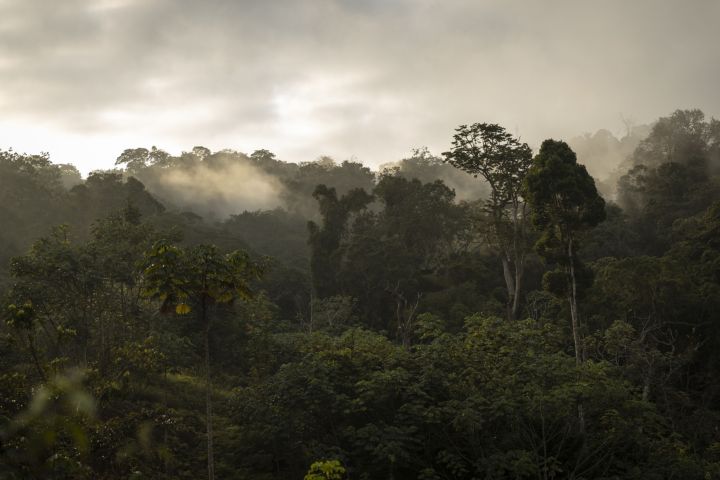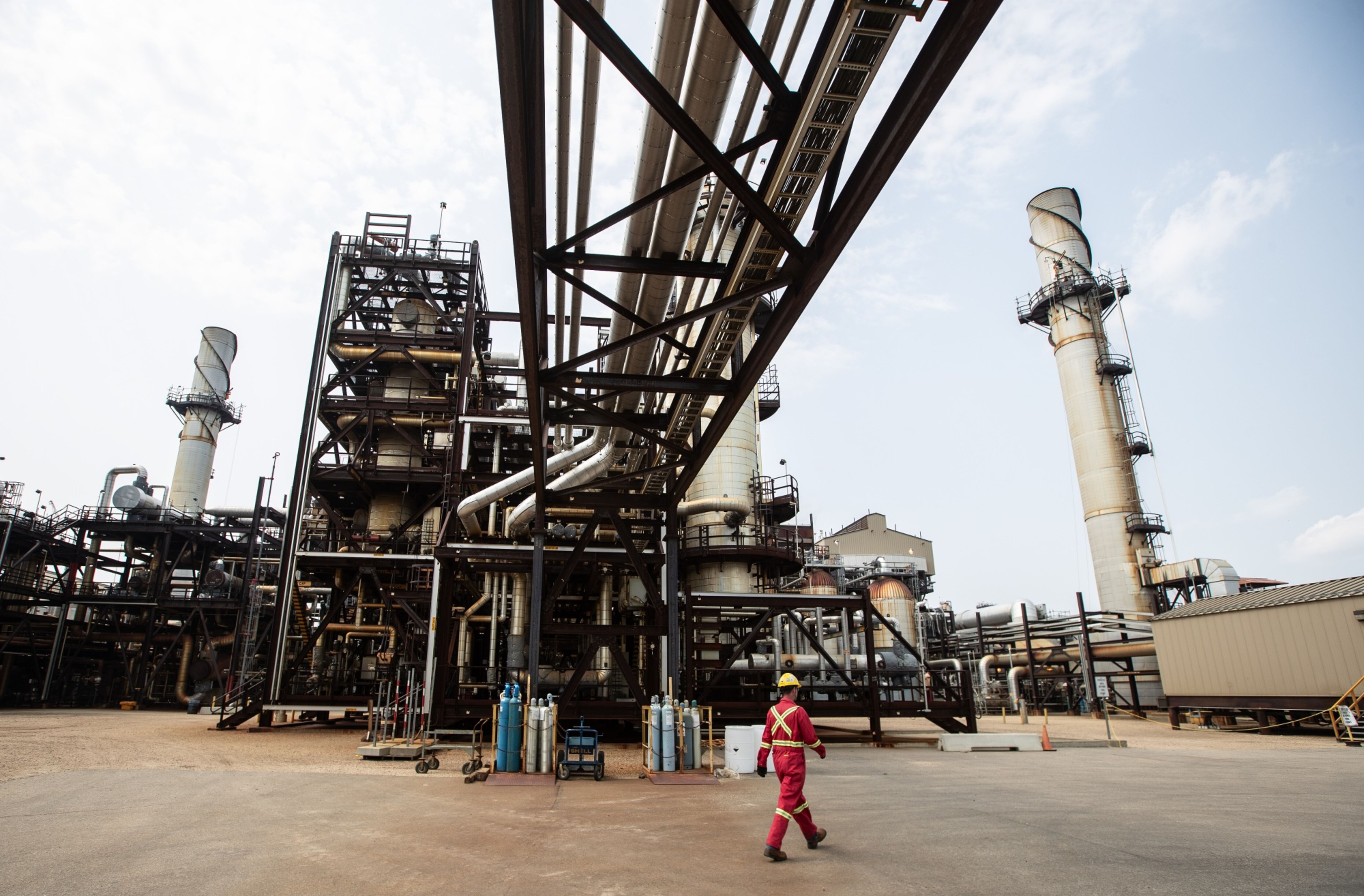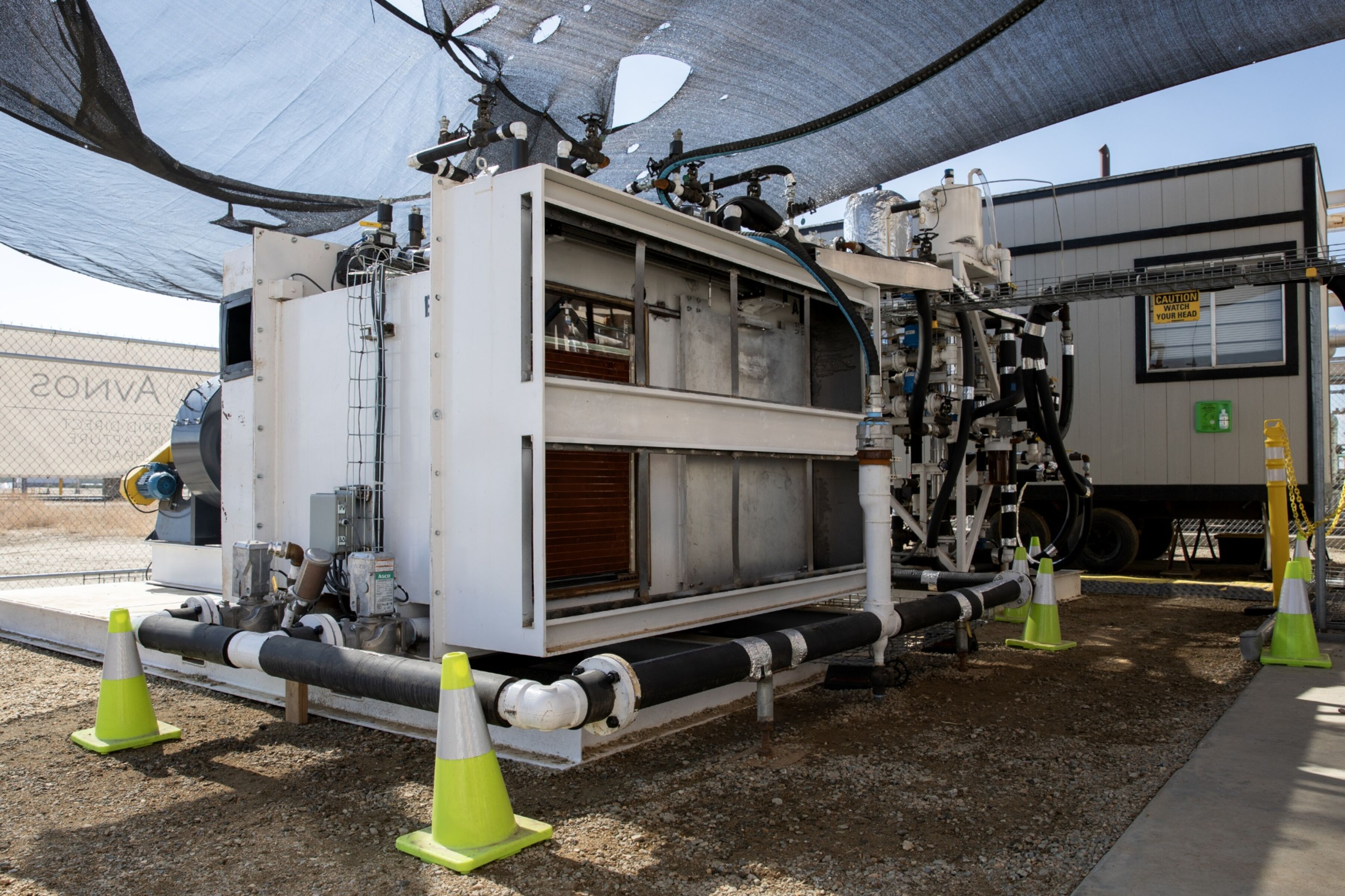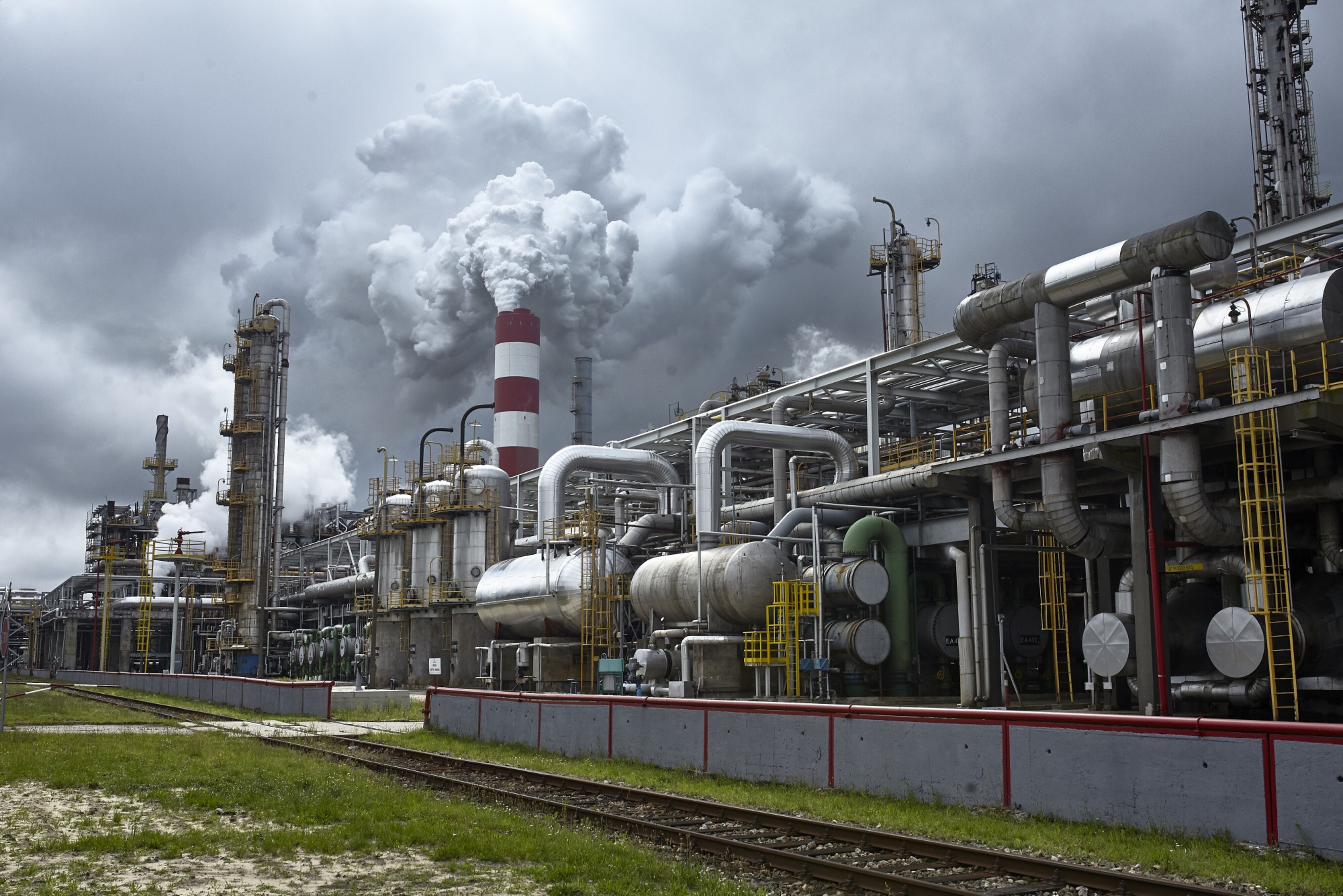COP28 CHEAT SHEET
Carbon capture is confusing. Here are 14 terms to help understand it

Given the role carbon capture will likely need to play in the coming decades if the world is to limit global warming — and its prominence at COP28 climate talks, Bloomberg Green is offering a cheat sheet to help demystify a market that could be worth as much as $1 trillion by the end of the 2040s, according to BloombergNEF.
Flip to the glossary of any climate report and it will look like a cat ran over a keyboard.
That’s particularly true when it comes to talking about carbon capture. The acronyms — DAC, MRV and EOR, to name just a few — are head-spinning. Throw in phrases like “enhanced rock weathering” and “carbon sink” and it’s enough to make you want to throw the report into a lake.
But given the role carbon capture will likely need to play in the coming decades if the world is to limit global warming — and its prominence at COP28 climate talks — that’s not advisable. Bloomberg Green is offering a cheat sheet to resist that urge and help demystify a market that could be worth as much as $1 trillion by the end of the 2040s, according to BloombergNEF.
It remains to be seen whether any of these technologies that keep carbon dioxide from the atmosphere, move it around, store it and even remove it can grow to a meaningful scale. Many of these methods are still in their early stages and those that have been around for decades have largely failed to deliver on their promises. Given the world will likely need to remove billions of tons of carbon annually by mid-century if it is to limit global warming to 1.5C, at least some of these technologies will (hopefully) play a role in reducing atmospheric CO2. With countries searching for new ways to address the climate crisis beyond needed, rapid cuts to carbon emissions, the list is also likely to grow.

The Shell Quest Carbon Capture and Storage facility near Edmonton, Alberta, Canada, on Monday, July 20, 2023. To hit its net zero targets, the world is relying on a controversial technology pioneered by the fossil fuel industry.
Carbon dioxide removal (CDR)
What it is: Decades of delay in lowering emissions mean the world will almost certainly have to find ways to take billions of tons of CO2 out of the atmosphere. Carbon dioxide removal is a catch-all term for solutions designed to do just that. It can be done using machinery to capture CO2 from ambient air or accelerating natural processes that pull the gas from the atmosphere.
What its limitations are: Many methods of engineered carbon removal are wildly expensive and there are no agreed-upon accounting standards. They also need to be paired with storage. (More on that later.) There’s a risk carbon removal could distract the world from pursuing urgently needed emissions cuts right now.
Point-source carbon capture
What it is: While CDR pulls the gas from the ambient air, point-source carbon capture grabs CO2 at the smokestack. The technology can be attached to everything from a coal-fired power plant to a steel factory. It doesn’t reduce the total volume of CO2 in the atmosphere; instead, it prevents additional emissions from ending up there.
What its limitations are: Similar to carbon removal, point-source carbon capture faces obstacles in hefty costs and technology readiness. Carbon capture figures prominently in the oil and gas industry’s plans despite numerous failures, raising concerns it could delay the transition to clean energy. Similar to CDR, companies engaged in point-source carbon capture also beg a question of where to store their captured carbon.
Read more: An Oil Giant Quietly Ditched the World’s Biggest Carbon Capture Plant
Direct air capture
What it is: The most sci-fi form of carbon removal, direct air capture uses machines to separate CO2 from the air. The process relies on specially formulated chemicals as well as natural products like limestone to grab CO2. That CO2 can then be stored underground, where it will be theoretically locked away for up to millennia.
What its limitations are: DAC is expensive, costing hundreds of dollars per ton of CO2. It can also be energy intensive. Removing 1 ton of CO2 requires up to 2,000 kilowatt-hours of clean energy, energy that would be diverted from the grid. (For reference, an average American home consumes 889 kWh per month.)

Avnos hybrid direct air carbon capture technology at a pilot site in Bakersfield, California. The Los Angeles-based startup is testing a machine that can suck carbon dioxide out of the air and produce water as a byproduct in the process. Photographer: Alisha Jucevic/Bloomberg
Carbon capture and utilisation (CCU)
What it is: Once CO2 is captured, it can be used as a feedstock in various products. That process is called carbon capture and utilisation, or sometimes just carbon reuse. One typical approach is to dissolve compressed CO2 in water to produce carbonated drinks. But a growing array of applications ranges from alternative polyesters to synthetic jet fuels.
What its limitations are: CCU is still expensive and requires a steady stream of CO2. Not every carbon utilization method guarantees long-term climate benefits. CO2 contained in a can of soda, for instance, will be released as soon as the can is opened.
Carbon capture and sequestration (CCS)
What it is: It’s not enough to remove CO2. The gas also needs to be stored. Engineers figured out how to store CO2 in spent oil and gas reservoirs in the 1960s. Forests also naturally sequester carbon. But a recent wave of startups has come up with novel forms of carbon capture and sequestration, including sinking agricultural waste to the bottom of the sea where oxygen-depleted deep water will prevent biomass decomposition as well as injecting the captured gas into concrete.
What its limitations are: Some approaches don’t lead to reliable carbon sequestration. When wildfires burn forests, for instance, CO2 can be released back into the atmosphere. Companies working on engineered sequestration claim that their approaches can store CO2 permanently, but those claims have yet to be proven at scale.
CO2 pipelines
What it is: While CO2 can be captured anywhere in the world, it cannot be stored anywhere due to safety concerns and geological limitations. Enter CO2 pipelines, a critical piece of carbon capture and storage infrastructure. Companies have built miles and miles of pipelines designated to transport compressed CO2. Both point-source carbon capture and DAC projects will need even more CO2 pipelines for long-distance delivery to storage sites.
What its limitations are: In a word, safety. Any leaks could deplete the surrounding air of oxygen, endangering those nearby. So far, CO2 pipelines in the US have had fewer incidents than those carrying crude oil, but CO2 pipelines also have a much smaller footprint, which could distort their safety record. Federal regulators are stepping up efforts to strengthen oversight of CO2 pipelines but it takes time to revise regulations.
Enhanced oil recovery (EOR)
What it is: The most problematic use of captured CO2 is forcing it underground to get more oil out of aging oil reservoirs. Yet the majority of the existing CCS projects in the world are used for enhanced oil recovery. Some companies have plans to deploy DAC and use the resulting CO2 to extract more oil while claiming the resulting fossil fuel is “net zero.”
What its limitations are: EOR could be used to prolong the production of oil and gas and the emissions that come with burning fossil fuels. That flies in the face of the best available research showing the world needs to rapidly wind down fossil fuel use.

Emissions rise from a smokestack at the PKN Orlen SA oil refinery in Plock, Poland, on Friday, July 17, 2020. Polish refiner PKN Orlen won conditional European Union approval to buy rival Grupa Lotos SA after agreeing on an extensive commitments package designed to allay potential competition concerns.
Carbon offset
What it is: Companies and governments can buy carbon offsets, which allow them to pay someone else to remove greenhouse gas emissions from the atmosphere or avoid emitting climate pollution in the first place. In theory, that offset cancels out the buyer’s emissions impact. Companies do this because, in some cases, reducing emissions is more expensive than paying to offset them.
What its limitations are: Many carbon offset projects have been shown to be flawed or, in some cases, completely useless. Misaligned incentive structures to offer the lowest costs have resulted in worthless credits that have done more to greenwash companies and make money for verifiers than result in real avoided emissions.
Carbon sink
What it is: A tree is a carbon sink. An ocean is a carbon sink. The soil is also a carbon sink. In short, anything that absorbs more CO2 from the atmosphere than it releases is a carbon sink. Besides natural ones, engineered solutions such as injecting CO2 into cement and geological formations are manmade forms of carbon sinks.
What its limitations are: Just like we can’t dump more garbage into a full trash bin, some carbon sinks have a limit. If oceans’ CO2 uptake exceeds a certain level, for example, the chemistry of seawater changes, causing ocean acidification and harming marine ecosystems. Other carbon sinks are vulnerable to extreme weather: This year’s wildfires unlocking a vast amount of CO2 stored in Canadian forests, for instance.
Trees in an area of dense primary forest in Nyanga, Gabon. Forests serve as major carbon sinks. Photographer: Guillem Sartorio/Bloomberg
Afforestation
What it is: Unlike reforestation — which targets regrowing trees on forestland — afforestation involves planting trees in areas that have not recently been covered with forests. As those trees grow, they pull CO2 out of the atmosphere. The benefits don’t just accrue to the climate. Afforestation can also help deal with desertification and clean up contaminated former industrial areas.
What its limitations are: The climate gains from afforestation can be easily burned down by wildfires, which are growing bigger and more frequent around the world. It’s also hard to find enough land for planting trees as the global population demands more space for housing, infrastructure and food production.
Monitoring, reporting and verification (MRV)
What it is: Depending on who you ask, MRV can stand for “monitoring, reporting and verification” or “measurement, reporting and verification.” In either case, the acronym is a key part of ensuring that CDR technology works as it’s intended. To do MRV, companies need to hire an independent auditor to measure the amount of CO2 removed and whether it stays out of the atmosphere. There are a number of techniques to do that, including installing sensors at storage sites, establishing carbon removal standards and publishing a registry of sales and deliveries.
What its limitations are: There are no set criteria for MRV and all efforts are voluntary. Because the carbon removal industry is so young, not many startups or auditors have developed strong MRV techniques.
Enhanced rock weathering (ERW)
What it is: Crushing certain types of rocks and spreading them on farmland can speed up the Earth’s natural rate of carbon absorption. It’s a multi-step process: First, the minerals in the rocks wash into streams and rivers, making waters less acidic. That allows the water to absorb more CO2, which is in turn consumed by plankton — tiny marine organisms — that take the CO2 to the ocean floor when they die. Apart from removing carbon, enhanced rock weathering can also boost crop yields as minerals in the crushed rocks replenish farmland.
What its limitations are: What works in theory doesn’t always work in real life. ERW advocates still need to prove that this practice can put away CO2 for good. The process takes years and spans many miles, which makes measurement difficult.
Ocean alkalinity enhancement (OAE)
What it is: While ERW aims to make water more alkaline by spreading rocks on land, ocean alkalinity enhancement (OAE) is focused on going right to the source. Dissolving rocks like olivine and basalt in seawater can help make the ocean more alkaline, allowing seawater to absorb more CO2 while also helping to combat ocean acidification.
What its limitations are: A lot remains unknown about OAE, including the impact dumping millions of tons of rock in and near the ocean will have on marine ecosystems. As an open-system approach to carbon removal, MRV is also a major challenge.
Read more: How Seeding the Oceans With Minerals Could Grab Carbon From the Atmosphere
Biochar
What it is: The charcoal-like, high-carbon substance made by burning agricultural and forestry waste in an oxygen-limited environment was first deployed centuries ago as a technique to fertilize depleted soil. Today, biochar offers a unique climate solution. That’s because when straw or sugarcane residue decay, the CO2 they captured while growing will be released. But creating biochar can prevent that release, turning biomass into a stable solid form that persists for potentially centuries, in theory locking the CO2 away for that long.
What its limitations are: Creating and transporting biochar can release tiny particulate matter harmful to human health. While biochar has been pitched as a soil additive to help agricultural yields, not all field experiments led to higher crop totals. DM





















 Become an Insider
Become an Insider
Comments - Please login in order to comment.